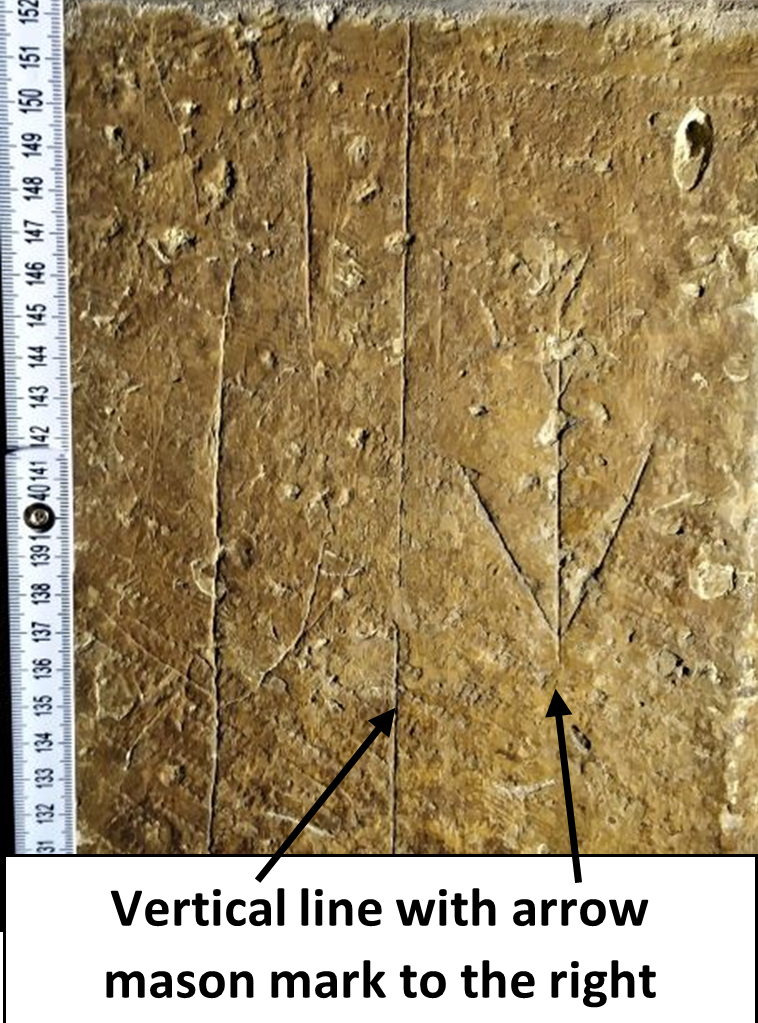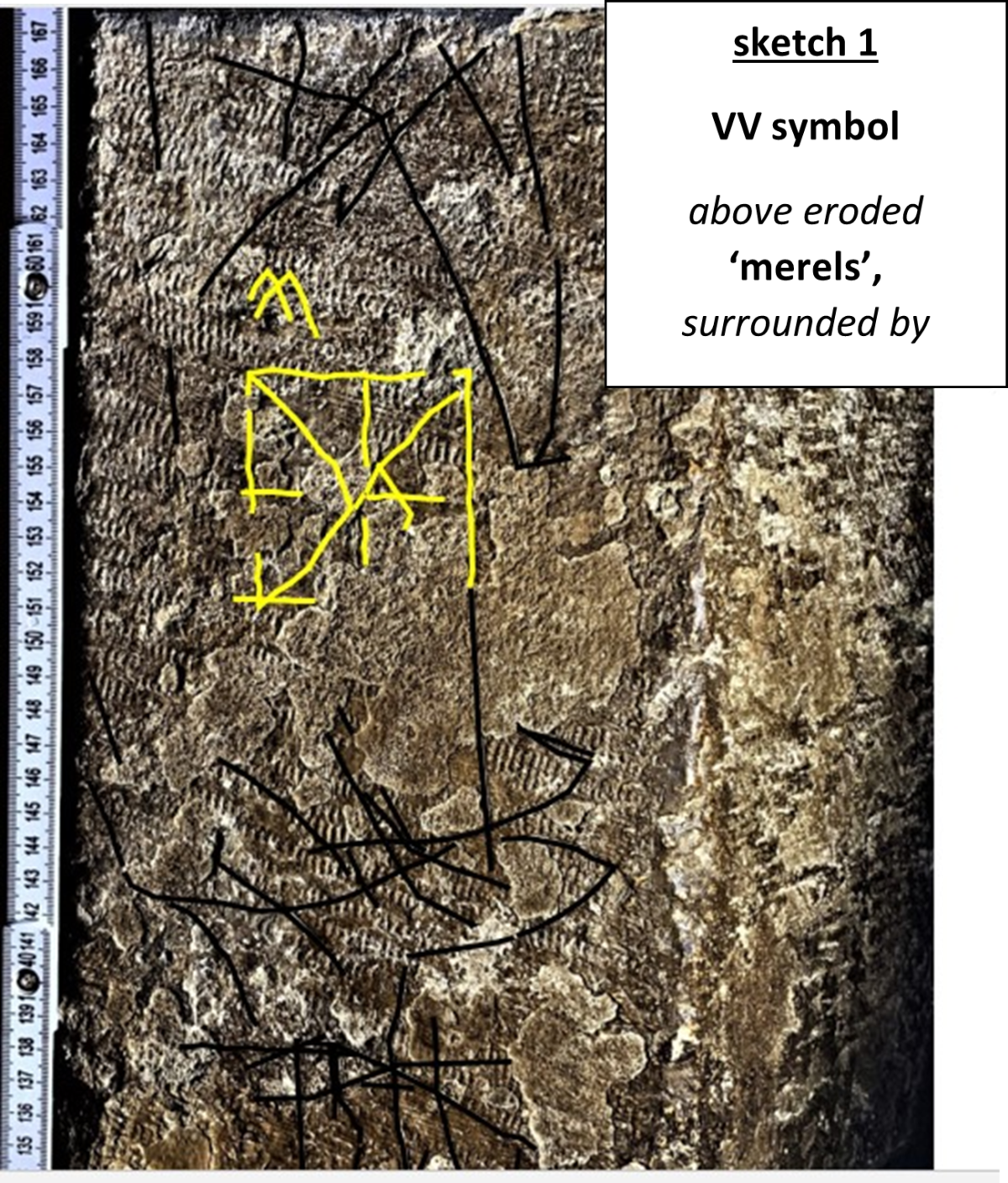Love them or hate them, graffiti is here to stay. Or rather it has been here a long, long time.
Thanks to Heritage Lincolnshire, a great opportunity has arisen to search for and record historic graffiti at Greyfriars building in central Lincoln. Nine enthusiastic volunteers have been busy recording the graffiti under the guidance of Brian Porter, project lead for the Lincolnshire Historic and Medieval Graffiti Survey.
Greyfriars has endured a long and varied history of functions, and some graffiti was already known to be present on walls of the upper floor. But is there any graffiti lurking in the cool dark shadows of the Undercroft? Yes indeed, more than we’d hoped for.
There are different types of graffiti, which is normally defined as images, symbols or letters informally carved or written onto a surface in public view. However, there is a group of symbols known as mason marks, usually each symbol coming from one mason or gang of masons. The ones found in the Undercroft were only found on the central pillars…

Note that the first three are almost certainly from the same carver or team, but are inverted or subtle variations of each other. This is the commonest mason mark found in the Undercroft. These would have been carved on a mason’s ‘banker’ bench prior to the pillars being built in the13th century AD. Modern masons often have their own mark too, so this is a well-established tradition, although the terms and conditions of employment in medieval England would have been somewhat different from today.
Also, several alignment marks have been found; these are usually close to the centre of a block of stone, typically on pillars, to assist with accurate carving and laying of blocks during building. Not vertical = falling down! Other types of mason mark that have not been found here are quarry marks, or assembly marks more often found on timbers.


Several circle-based graffiti are found too, with one being double concentric and one being triple concentric. All but one were very neatly carved, as if by a set of masons’ compasses or similar. They are all found on central pillars, are faint and some are partial circles or only arcs.


Why would people have carved neat circles? Not just for fun perhaps, but possibly because circles have significant symbolism in ecclesiastical and secular settings. Precisely what meaning was intended by each of the carvers is known with certainty only by them. However, possible meanings include eternity and sacred union in Christianity, natural balance to the ancient Greeks, or the sun / moon for many cultures. Dating these graffiti is notoriously difficult, thus linking meanings with their contemporary culture is nigh on impossible.
‘Memorial’ or ‘tourist’ graffiti, i.e. names or initials and dates, are also present with about 30 examples of initials or letters. Again, the quality is generally poor due to the friable stone surfaces, and there are several possible memorial graffiti where the letters are badly eroded and unreadable.


The clearest and most complete memorial graffito in the Undercroft is of F SHARPE 1917, lightly carved and highlighted with pencil or ink.

Hopefully we can discover more about the person who carved their name here during the tumultuous First World War. The story of their life, or maybe finding their descendants, would be a great outcome of further research.
Now let’s have a look at some of the more unusual graffiti in the Undercroft, and try to work out what messages the carvers were trying to leave behind.
This jumble of faint scratches found on one pillar (sketch 1) has been examined by digital enlargement and enhancement, and an overlaid sketch added as shown.

A tiny ‘crossing-Vs’ symbol is seen above a partial square with internal lines, known as a ‘merels’. (The graffiti themselves have neutral colours, but by adding colours to the scratch marks seen on a computer we can begin to distinguish different symbols more easily.)
The crossing-Vs symbol is widespread in churches and old secular buildings. It is also known as a Marian Mark. Note that the term ‘witch mark’ is often applied to these, but this is too specific a term. Medieval and post-Medieval minds were fed with stories and images of devils, demons, malicious spirits, bizarre creatures and not just witches. The crossing-V symbol can be found orientated to mimic a letter W or M, and is fairly common in older buildings, especially churches.
Currently it is believed that these were one of a group of different symbols that were carved to give protection to the building and/or for the carver, by warding off evil or to invoke protection by the Virgin Mary.
On the other hand is the merelsv pattern, which is often called a ‘3-mens morris’ or ‘mills’. This is the simplest form of the mens morris gameboard, more usually found as a 9 mens morris. More on this in the next blog…
Another crossing-V mark was found, this time with scratch marks surrounding it (sketch 2). These scratches appear to give a simplified outline of a human figure that has subsequently been crossed out with horizontal lines. This is speculative, or even wishful thinking!
The stone surfaces are friable and eroding, and it may simply be that the human mind (mine!) is trying to make order from chaos by seeing patterns where none exist. This phenomenon is known as ‘pareidolia’ meaning the perception of apparently significant patterns or recognizable images, especially faces, in random or accidental arrangements of shapes and lines.
It’s worth noting that prior to being plastered, stones were often roughly scored to assist the plaster to stick to the stone.
The final image is just as intriguing. Again it is partial due to erosion or damage to the stone surface.
Computer enhancement, and adding an overlay sketch, reveals the clear shape of the sole of a ‘pointy shoe’, shown here in black outline, with a hint of the heel below.
The enigmatic carved lines and marks shown in blue are probably unrelated. Shoe/foot/hand graffiti are not uncommon, continuing a tradition since prehistoric people left their hand and feet marks as cave art. Lead workers have been leaving hand and shoe marks on fonts and lead rooves right up to modern times.
Some shoe carvings are drawn on flat surfaces and may be a memento of a pilgrim visit, drawn around a real shoe, although this one at Greyfriars is on the vertical surface of a pillar. It is estimated to be 160mm long and therefore too small to fit an adult. Many cultures have ritual or folk meanings for shoes, and real shoes have been found hidden inside walls of old buildings. 
The ‘pointy shoe’ is characteristic of the late 14th to 15th century medieval fashion of ‘poulaines’ originating in what is now Poland. Alternatively, it is a representation of a teddy boys 20th century winkle-picker!
If you would like to know more about Greyfriars graffiti, another blog will be coming out soon presenting a selection of graffiti found in the upper storey. In the mean-time have a look in your nearest church to see if you can find any.
A list of churches known to have graffiti can be found at the website of Lincolnshire Graffiti Survey…apologies that it hasn’t been updated for ages!
https://lincsgraffiti.wixsite.com/lmgs
Information about Heritage Lincolnshire and the Greyfriars project is at: https://www.heritagelincolnshire.org/projects/greyfriars-in-lincoln
